Top 10 Insights from Customer Service Benchmarking Reports
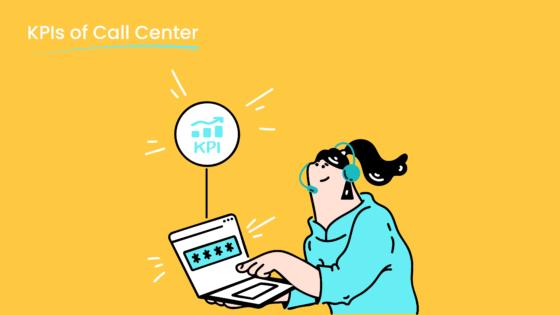
Benchmarking customer service is essential for shaping strategies as we approach 2025. It enables businesses to identify gaps, measure performance, and enhance customer satisfaction. With companies losing $75 billion annually due to poor service and only 25% of call centers effectively utilizing AI automation, the need for improvement is clear. As the customer service software market is expected to grow from $14.9 billion to $68.19 billion by 2031, leveraging benchmark customer service metrics offers actionable insights to maintain a competitive edge. For instance, implementing segmentation strategies based on benchmarked customer feedback can increase satisfaction scores by 30%. Solutions like Sobot’s tools unify interactions, improve net promoter scores, and optimize the customer experience, driving long-term success.
Omnichannel Support: A Benchmark for Seamless Customer Experience

Defining Omnichannel Support in 2025
Omnichannel support has become a cornerstone of modern customer service. By 2025, it will represent the gold standard for delivering a seamless customer experience across multiple communication channels. Customers increasingly expect consistent interactions, whether they reach out via email, social media, live chat, or phone. In fact, 86% of consumers now demand smooth transitions between channels when engaging with customer support agents. This expectation underscores the importance of integrating all touchpoints into a unified system that eliminates context loss and ensures efficient resolutions.
For businesses, omnichannel support is more than just a convenience—it's a competitive necessity. It allows you to meet customers where they are, offering personalized and efficient service that builds loyalty. Companies that adopt this approach often see higher retention rates and improved satisfaction scores, making it a critical benchmark for success.
Key Customer Service Metrics for Omnichannel Success
To measure the effectiveness of your omnichannel strategy, you need to track specific customer service metrics. These benchmarks provide actionable insights into how well your system performs. Here’s a breakdown of key metrics:
| Metric | Description |
|---|---|
| Customer Effort Score (CES) | Evaluates how easy it is for customers to resolve issues across channels. Lower scores indicate better experiences. |
| Channel Attribution | Identifies which channels customers prefer, helping you allocate resources effectively. |
| Cross-Channel Resolution Time | Tracks the total time taken to resolve issues across multiple channels. |
| Context Loss Rate | Measures how often customers need to repeat information when switching channels. High rates signal integration issues. |
By focusing on these metrics, you can refine your approach and ensure your omnichannel system delivers maximum value.
Sobot’s Omnichannel Solution: Enhancing Customer Interactions
Sobot’s omnichannel solution sets a new benchmark for seamless customer interactions. It integrates multiple communication channels—voice, email, social media, and live chat—into a unified workspace. This approach eliminates context loss and empowers agents with complete customer histories, enabling faster and more personalized resolutions. The platform also leverages AI-driven automation to handle repetitive queries, freeing up agents to focus on complex issues.
The results speak for themselves. Businesses using Sobot’s solution have reported a 20% reduction in inbound discussion volume and a 96%+ positive feedback rate. Additionally, the system achieves an impressive 95% customer satisfaction rate and a 99% customer happiness rate. These metrics highlight the platform’s ability to enhance the overall customer experience while driving operational efficiency.
By adopting Sobot’s omnichannel solution, you can transform your customer service operations, improve net promoter scores, and deliver the personalized experiences your customers expect.
Personalization: The Cornerstone of Customer Satisfaction
Why Personalization is a Game-Changer in 2025
Personalization has become a critical driver of customer satisfaction. By 2025, businesses that tailor their services to individual needs will see significant benefits. Customers increasingly expect brands to understand their preferences and provide relevant solutions. For instance, companies using AI to personalize experiences report a 40% increase in revenue and a 20% rise in satisfaction. Additionally, 80% of customers are more likely to purchase from brands offering personalized interactions. These figures highlight how personalization not only enhances the customer experience but also boosts loyalty and spending.
AI-driven personalization is transforming industries like e-commerce and financial services. It enables businesses to deliver tailored recommendations, improving engagement and retention. By adopting personalization strategies, you can create meaningful connections with your customers, ensuring they feel valued and understood.
Benchmarking Customer Service Metrics for Personalization
To measure the success of personalization, you need to track specific customer service metrics. These benchmarks provide insights into how well your strategies perform:
| Metric | Insight |
|---|---|
| Customers' Spending | Extremely satisfied customers spend 37% more than dissatisfied ones. |
| Transaction Size | Easy experiences lead to 23% higher spending per transaction. |
| Business Performance | 89% of businesses with above-average experiences outperform competitors. |
These metrics emphasize the financial and operational advantages of personalization. By focusing on customer feedback and satisfaction, you can refine your approach and achieve better results.
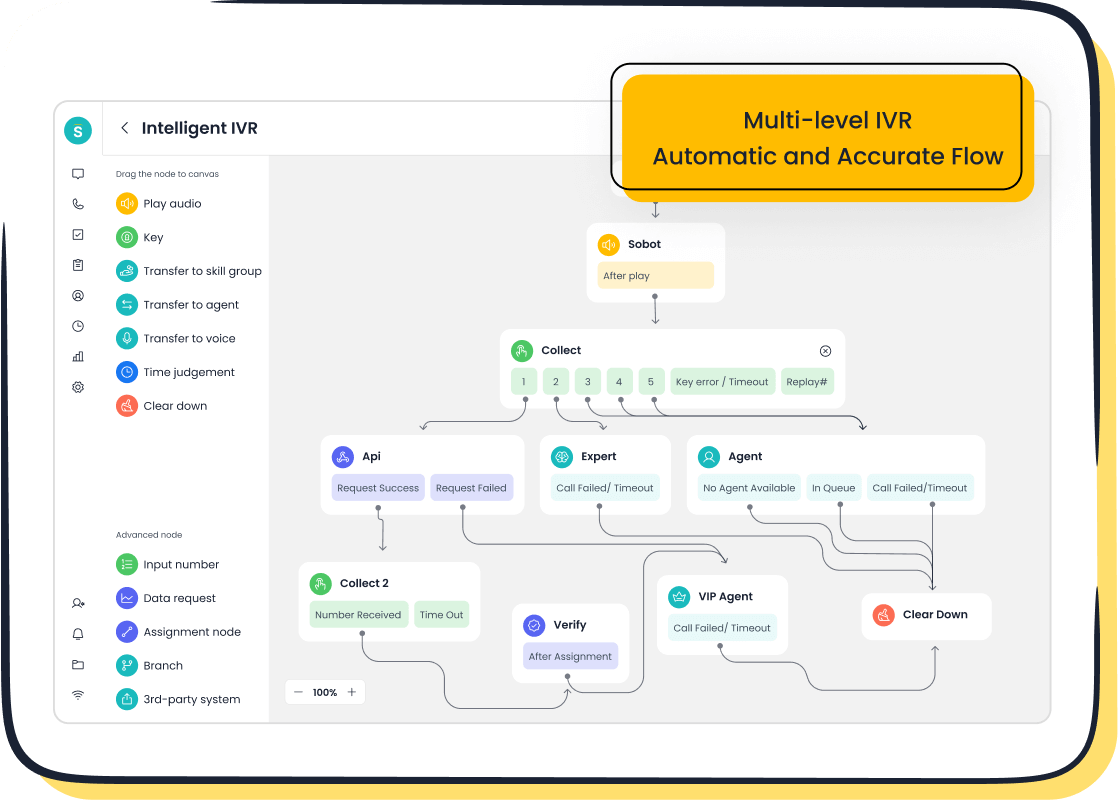
Examples of Personalization with Sobot’s Voice/Call Center
Sobot’s Voice/Call Center exemplifies how personalization can elevate customer service. The platform uses intelligent IVR and AI-powered Voicebots to customize interactions. For example, it recognizes customer intent and routes calls to the most suitable agent. This reduces wait times and ensures efficient resolutions. Additionally, the unified workspace provides agents with complete customer histories, enabling them to offer tailored solutions.
Businesses using Sobot’s Voice/Call Center have reported higher net promoter scores and improved customer satisfaction. The platform’s ability to integrate with CRM systems ensures seamless data connectivity, further enhancing the customer experience. By leveraging Sobot’s tools, you can deliver personalized service that meets the latest customer feedback and expectations.
AI and Automation: Transforming Customer Service Benchmarks

The Role of AI in Reducing Customer Effort
AI has revolutionized customer service by simplifying interactions and reducing the effort customers need to resolve issues. High-effort experiences often lead to dissatisfaction, with 96% of customers becoming disloyal after encountering such interactions. AI tools, like chatbots and voicebots, address this challenge by resolving simple queries on the first contact. This eliminates the need for follow-ups and ensures faster resolutions.
Automation also empowers customers to solve problems independently through self-service options. For example, AI-powered chatbots provide instant answers to frequently asked questions, allowing customers to bypass long wait times. These tools not only enhance efficiency but also improve the overall customer experience. By adopting AI, you can reduce friction in customer interactions and build stronger loyalty.
Benchmarks for AI-Driven Customer Experience
AI has set new benchmarks for improving customer service metrics. The following table highlights key performance indicators (KPIs) before and after AI implementation:
| KPI | Before AI | After AI | Improvement |
|---|---|---|---|
| ⏱️ First Response Time | 8.2 minutes | 2.1 minutes | −74% |
| ☎️ Average Handle Time | 6.5 minutes | 2.9 minutes | −56% |
| 😊 Customer Satisfaction | 78% CSAT | 97% CSAT | +24% |
| 🤝 Net Promoter Score | 23 | 63 | +174% increase |
| 🔄 Self-Service Rate | 41% | 71% | +72% |
These improvements demonstrate the transformative impact of AI on customer service. By reducing response times and enhancing satisfaction, AI helps businesses achieve higher net promoter scores and operational efficiency.
Sobot’s AI-Powered Voicebot: A Case Study
Sobot’s AI-powered Voicebot exemplifies how automation can redefine customer service benchmarks. The Voicebot uses advanced AI to recognize customer intent and provide accurate responses. Over 80% of its answers are correct, significantly reducing the need for human intervention. Businesses using Sobot’s Voicebot have achieved a 95% customer satisfaction rate and a 20% reduction in inbound discussion volume over two years.
The platform also excels in improving key metrics. For instance, it cuts first response times by 74% and reduces average handle times by 56%. These results align with industry benchmarks, showcasing Sobot’s ability to deliver exceptional customer experiences.
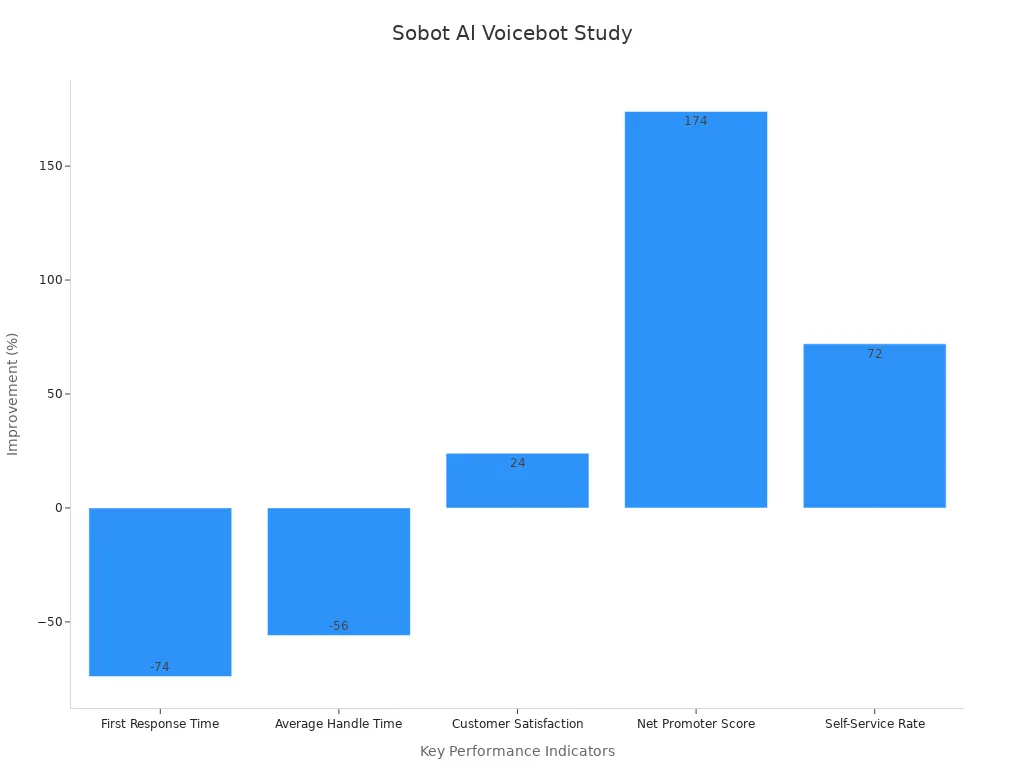
By integrating Sobot’s AI-powered solutions, you can enhance customer feedback, streamline operations, and achieve measurable improvements in customer service metrics.
Customer Effort Score (CES): A Key Metric for Success
Understanding CES and Its Importance
Customer Effort Score (CES) measures how easy it is for customers to resolve their issues or complete a task when interacting with your service. It has become a vital benchmark customer service metric because customers value convenience above all else. Research shows that minimizing effort leads to long-term loyalty. High-effort interactions, on the other hand, often result in customer churn. When customers struggle to resolve their problems, they are more likely to switch to competitors. This makes CES a critical indicator of customer satisfaction and retention.
For example, if a customer has to repeat their issue multiple times across different channels, their experience becomes frustrating. By focusing on reducing such friction, you can improve customer satisfaction and build stronger relationships. CES not only reflects the quality of your service but also highlights areas where you can enhance the customer experience.
Industry Standards for CES in 2025
By 2025, CES will remain a key focus for businesses aiming to improve customer service. Industry leaders are setting benchmarks to ensure low-effort experiences. A CES score of 5 or higher (on a 7-point scale) is considered excellent. Companies achieving this score often see higher customer retention rates and positive feedback.
The latest customer feedback trends emphasize the importance of seamless interactions. Customers expect quick resolutions without unnecessary steps. For instance, integrating AI tools like Sobot’s Voice/Call Center can streamline processes, reducing the effort required to resolve issues. These tools ensure that customers receive accurate and timely support, aligning with industry standards for CES.
Strategies to Improve CES with Sobot’s Unified Workspace
Sobot’s Unified Workspace offers a powerful solution to improve CES. It consolidates customer data and interactions into a single platform, eliminating the need for customers to repeat information. Agents can access complete customer histories, enabling faster and more personalized resolutions. This reduces the effort customers need to exert, enhancing their overall experience.
The platform also integrates AI-driven automation to handle repetitive queries. This allows agents to focus on complex issues, ensuring efficient service delivery. Businesses using Sobot’s Unified Workspace have reported significant improvements in customer satisfaction and loyalty. By adopting such tools, you can align with the latest customer feedback and set new benchmarks for CES in your industry.
Proactive Support: Setting New Standards in Customer Service
What is Proactive Support and Why It Matters
Proactive support shifts the focus from reacting to customer issues to anticipating and addressing them before they arise. This approach enhances the customer experience by saving time and reducing frustration. For example, notifying customers about potential delays or offering solutions to common problems demonstrates care and builds trust. Proactive support also strengthens customer loyalty and boosts team productivity by minimizing repetitive queries.
The benefits of proactive support extend beyond customer satisfaction. Businesses adopting this strategy often see reduced reactive tickets and increased retention rates. Additionally, proactive engagement leads to higher Net Promoter Scores (NPS), reflecting greater advocacy and satisfaction. By addressing issues early, you can create a seamless experience that keeps customers coming back.
Benchmarks for Proactive Customer Engagement
Proactive customer engagement has become a key benchmark for success in customer service. The following table highlights statistical insights that emphasize its importance:
| Statistic | Source |
|---|---|
| Over 50% of customers will switch to a competitor after a single unsatisfactory customer experience. | Zendesk Blog |
| 80% increase in revenue for companies that focus on customer experience. | Zippia |
| Customer-centric brands report profits that are 60% higher than those that fail to focus on CX. | CX Index |
| 90% of businesses have made CX their primary focus. | CX Index |
| 73% of customers consider CX the number one factor when deciding to purchase. | PwC |
These benchmarks highlight the growing emphasis on customer-centric strategies. By prioritizing proactive engagement, you can align with industry standards and improve your service outcomes.
Tools for Proactive Support: Insights from Sobot
Sobot offers advanced tools to help you implement proactive support effectively. Its unified workspace provides agents with real-time customer insights, enabling them to anticipate needs and offer tailored solutions. For instance, Sobot’s AI-driven automation identifies patterns in customer feedback, allowing you to address recurring issues proactively.
The platform also includes features like strategic revenue management and proactive planning. These tools optimize resource allocation and improve operational efficiency. Businesses using Sobot’s solutions report better customer satisfaction and reduced effort scores, setting new benchmarks in customer service metrics. By leveraging these tools, you can stay ahead of customer expectations and deliver exceptional experiences.
Self-Service Options: Empowering Customers in 2025
Popular Self-Service Channels and Their Impact
Self-service channels empower customers by enabling them to resolve issues independently. Popular options include chatbots, knowledge bases, and interactive FAQs. These tools reduce reliance on human agents and improve efficiency. For example, 70% of customers expect businesses to offer self-service applications, and 67% prefer self-service over speaking to representatives. Businesses that implement these channels see a 25% reduction in support ticket volumes and a 20% increase in customer satisfaction.
Self-service also aligns with the growing demand for convenience. By 2026, 60% of customer service engagements will occur through self-service channels, up from 45% in 2023. This shift highlights the importance of adopting these solutions to meet customer expectations.
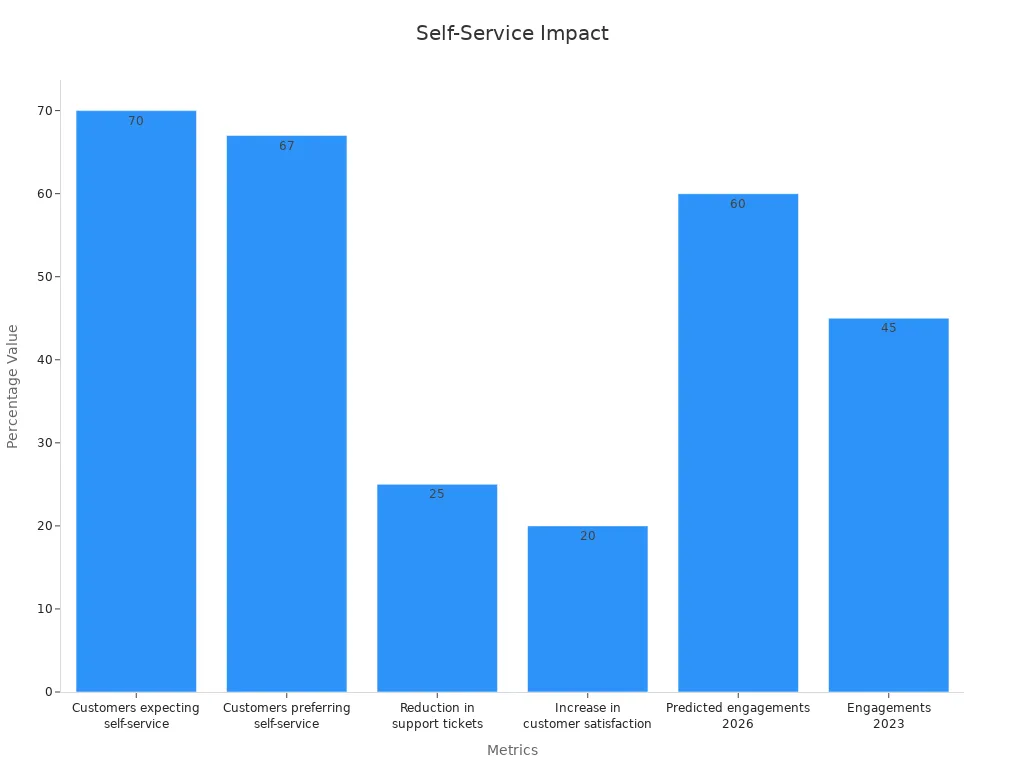
Evaluating Self-Service Effectiveness with Customer Service Metrics
Evaluating self-service effectiveness requires tracking key customer service metrics. These benchmarks provide insights into how well your channels perform:
| Metric | Value |
|---|---|
| Customer Satisfaction (CSAT) | 89% |
| Net Promoter Score (NPS) | 14 |
| CSAT when first contact resolved | 90% |
| CSAT after third contact | 83% |
| Customer Effort Score (CES) | 67 |
| NPS when issues unresolved | -25 |
| CSAT when issues unresolved | 50% |
These metrics emphasize the importance of resolving issues quickly and accurately. For instance, CSAT scores drop significantly when customers require multiple contacts to resolve their problems. By focusing on first-contact resolution, you can enhance satisfaction and loyalty.
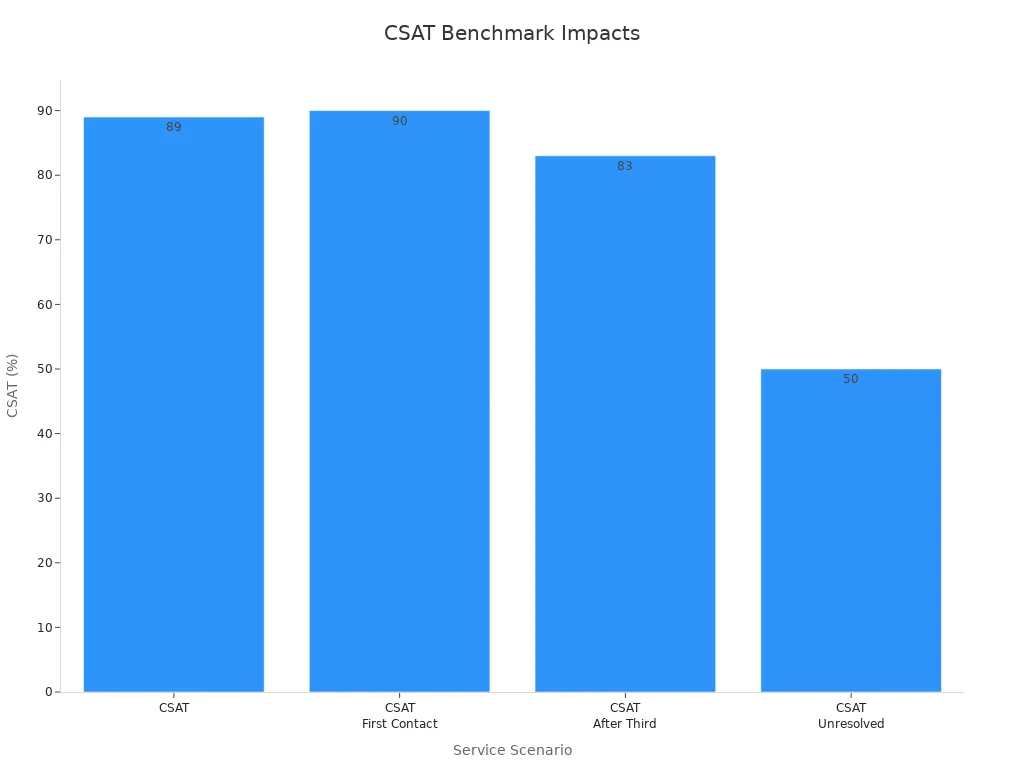
Enhancing Self-Service with Sobot’s Chatbot and Knowledge Base
Sobot’s Chatbot and Knowledge Base redefine self-service by offering intelligent and user-friendly solutions. The Chatbot, powered by AI and ChatGPT, handles 70% of customer inquiries without human intervention. It provides instant answers, reducing wait times and improving satisfaction. The Knowledge Base complements this by offering a centralized repository of information, enabling customers to find solutions independently.
These tools not only enhance the customer experience but also optimize operations. Businesses using Sobot’s self-service solutions report a 35% increase in satisfaction and a significant reduction in agent workload. By adopting Sobot’s Chatbot and Knowledge Base, you can empower customers, streamline processes, and align with the latest customer feedback trends.
First Contact Resolution (FCR): A Critical Benchmark
Why FCR is Essential for Customer Satisfaction
First Contact Resolution (FCR) plays a vital role in shaping the customer experience. It measures how effectively your service resolves issues during the first interaction. Customers value quick and efficient solutions, and failing to meet this expectation often leads to dissatisfaction.
- 9 out of 10 times, dissatisfaction stems from the failure to achieve FCR.
- Approximately 40% of customers switch to competitors when FCR is not achieved.
- For every 1% improvement in FCR, customer satisfaction increases by 1%.
- 95% of customers remain loyal to businesses that resolve their issues on the first attempt.
These statistics highlight why FCR is a critical benchmark customer service metric. By focusing on FCR, you can reduce churn, improve satisfaction, and build long-term loyalty.
Industry Benchmarks for FCR in 2025
Understanding industry benchmarks helps you evaluate your FCR performance. In 2025, the following FCR rates are considered standard across key sectors:
| Sector | FCR Rate (%) |
|---|---|
| Healthcare | 71 |
| Banking | 71 |
| Retail | 78 |
| Insurance | 76 |
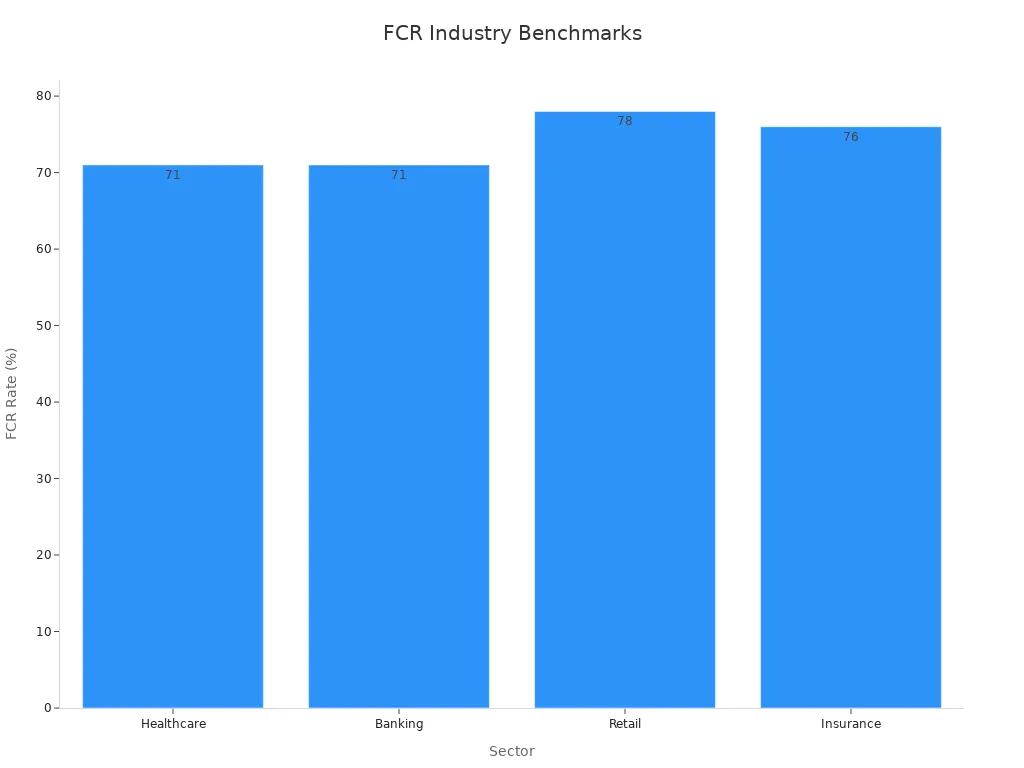
These benchmarks provide valuable insights into how your service compares to industry leaders. For example, retail businesses achieving a 78% FCR rate often report higher customer satisfaction and retention.
Improving FCR with Sobot’s Smart Call Routing
Sobot’s Smart Call Routing offers a powerful solution to enhance FCR. This feature intelligently directs customer inquiries to the most suitable agent based on their needs. By reducing misdirected calls, it ensures faster resolutions and minimizes customer effort.
The platform’s unified workspace further supports FCR by providing agents with complete customer histories. This eliminates the need for customers to repeat information, streamlining the resolution process. Businesses using Sobot’s Smart Call Routing have reported significant improvements in FCR rates, leading to better customer feedback and satisfaction.
By adopting tools like Sobot’s, you can align with the latest customer feedback trends and set new benchmarks for FCR in your industry.
Customer Feedback and Sentiment Analysis: Driving Improvements
The Value of Listening to Customers
Listening to your customers is one of the most effective ways to improve your service. Their feedback provides a direct window into their experiences, helping you identify what works and what needs improvement. For example, customer satisfaction surveys can capture opinions and feelings about specific interactions or overall service quality. Targeted questions in these surveys reveal satisfaction levels and pinpoint areas requiring attention.
Metrics like Net Promoter Score (NPS), Customer Satisfaction Score (CSAT), and Customer Effort Score (CES) are essential tools for understanding customer feedback. These benchmarks measure loyalty, satisfaction, and ease of interaction, respectively.
| Metric | Description |
|---|---|
| Net Promoter Score (NPS) | Measures customer loyalty and likelihood to recommend the product or service. |
| Customer Satisfaction Score (CSAT) | Assesses customer satisfaction with a specific interaction or overall experience. |
| Customer Effort Score (CES) | Evaluates the ease of customer interaction and resolution of issues. |
By actively listening to your customers, you can uncover valuable insights that drive meaningful improvements in your service.
Tools for Sentiment Analysis in 2025
Sentiment analysis tools have become indispensable for understanding the emotions behind customer feedback. These tools use AI to analyze text from surveys, reviews, and social media, identifying whether the sentiment is positive, negative, or neutral. By 2025, advancements in AI will make these tools even more accurate and accessible.
For example, businesses can use sentiment analysis to detect dissatisfaction early and take proactive steps to address it. Tracking metrics like CSAT and NPS alongside sentiment data helps you measure the impact of feedback-driven changes. Companies that prioritize sentiment analysis often see higher retention rates and revenue growth.
Sobot’s data analytics platform integrates sentiment analysis seamlessly. It provides real-time insights into customer emotions, enabling you to make informed decisions and improve the overall customer experience.
Leveraging Feedback with Sobot’s Data Analytics
Sobot’s data analytics tools empower you to turn customer feedback into actionable strategies. The platform consolidates data from multiple channels, offering a unified view of customer interactions. This allows you to identify trends, measure satisfaction, and track key customer service metrics like CES and NPS.
For example, Sobot’s analytics can highlight recurring issues, enabling you to address them proactively. Businesses using these tools have reported measurable improvements in satisfaction and loyalty. By leveraging Sobot’s solutions, you can stay ahead of the latest customer feedback trends and set new benchmarks for service excellence.
Employee Experience: The Hidden Driver of Customer Satisfaction
The Connection Between Employee and Customer Satisfaction
Your employees are the backbone of your customer service operations. When they feel engaged and supported, their performance improves, directly impacting the customer experience. Studies show that higher levels of employee engagement lead to increased customer satisfaction and retention. Engaged employees are more likely to go the extra mile, ensuring customers leave interactions feeling valued and understood.
Consider this: when employees feel connected to their work, they create positive experiences that resonate with customers. This connection fosters loyalty and trust, two critical components of long-term customer relationships. By prioritizing employee well-being, you not only improve internal morale but also set the stage for exceptional customer service.
| Metric | Description |
|---|---|
| Employee Engagement | Location-level employee engagement linked to customer satisfaction and retention. |
| Customer Satisfaction | Higher levels of employee engagement lead to increased customer satisfaction. |
| Customer Retention | Employee engagement positively impacts customer retention, a key performance metric for CRM. |
Benchmarks for Employee Engagement in Customer Service
Tracking employee engagement is essential for maintaining high standards in customer service. Benchmarks provide insights into how well your team performs and where improvements are needed. For example, companies with engagement scores above 70% often report higher customer satisfaction rates. Additionally, businesses with engaged employees see a 21% increase in productivity and a 10% boost in customer retention.
Key metrics to monitor include employee turnover rates, satisfaction surveys, and productivity levels. These indicators reveal how well your team aligns with organizational goals and customer expectations. By focusing on these benchmarks, you can create a supportive environment that drives both employee and customer success.
Enhancing Employee Experience with Sobot’s Unified Workspace
Sobot’s Unified Workspace offers a comprehensive solution to enhance employee experience. The platform consolidates customer interactions and data into a single, easy-to-use interface. This reduces the time agents spend switching between systems, allowing them to focus on delivering exceptional service. With access to complete customer histories, your team can resolve issues faster and with greater accuracy.
The Unified Workspace also integrates AI-driven tools to automate repetitive tasks. This not only boosts efficiency but also reduces employee burnout. Businesses using Sobot’s solutions report a 30% improvement in agent productivity and higher satisfaction scores across the board. By investing in tools like Sobot’s, you empower your employees to perform at their best, ensuring a seamless customer experience.
Sustainability and Social Responsibility: A New Benchmark
Why Sustainability is a Priority for Customers
Sustainability and social responsibility have become essential in shaping customer expectations. Customers increasingly prefer brands that align with their values, especially regarding environmental and social impact. Studies show that 83% of consumers believe companies should lead the way in establishing ESG (Environmental, Social, and Governance) best practices. Furthermore, 76% of customers would stop buying from businesses that neglect these principles.
This shift reflects a growing demand for ethical and sustainable operations. Customers want transparency and accountability in how companies manage resources and contribute to society. By prioritizing sustainability, you can build trust and loyalty, which are critical for long-term success.
Benchmarks for Sustainable Customer Service Practices
To meet these expectations, businesses must adopt benchmarks that reflect sustainable customer service practices. These benchmarks help measure progress and ensure alignment with customer values. Here’s a snapshot of recent data highlighting the importance of ESG in customer service:
| Statistic | Value |
|---|---|
| Percentage of S&P 500 companies releasing ESG reports | 90% |
| Consumers who believe companies should shape ESG best practices | 83% |
| Consumers who would stop buying from firms neglecting ESG practices | 76% |
These figures emphasize the need for businesses to integrate sustainability into their operations. Tracking customer service metrics like satisfaction and customer feedback can help you evaluate the impact of your ESG initiatives.
Examples of Sustainability in Action: Samsung and Sobot
Samsung’s collaboration with Sobot demonstrates how sustainability can enhance customer service. Samsung implemented Sobot’s all-in-one contact center solution to streamline operations and reduce inefficiencies. This integration not only improved customer satisfaction but also supported Samsung’s commitment to sustainable practices. By unifying communication channels, Samsung reduced resource consumption and enhanced team productivity by 30%.
Sobot’s solutions also contribute to sustainability by optimizing workflows and reducing repetitive tasks. Features like AI-driven automation and unified workspaces minimize energy usage while improving customer experience. These tools align with the latest customer feedback trends, ensuring businesses can meet both operational and ethical benchmarks.
By adopting sustainable practices, you can set new standards in customer service while addressing the growing demand for social responsibility.
Benchmarking customer service provides actionable insights that drive success in 2025. By adopting strategies like omnichannel support, personalization, and AI-driven automation, you can enhance customer experience and streamline operations. Continuous monitoring of metrics ensures ongoing improvement, while proactive support and self-service options empower customers.
| Key Insights from Benchmarking | Impact on Operational Efficiency |
|---|---|
| Identifying best practices from top performers | Helps organizations set realistic targets and implement effective strategies |
| Learning from customer service excellence of top-rated companies | Enhances customer experience and satisfaction levels |
| Continuous monitoring of performance metrics | Drives ongoing improvement and adaptation of strategies |
Sobot’s solutions unify customer interactions, reduce effort, and improve satisfaction. Explore these tools to stay ahead in customer service excellence.
FAQ
What is customer service benchmarking, and why is it important?
Customer service benchmarking compares your performance metrics to industry standards. It helps you identify gaps, improve customer satisfaction, and stay competitive. For example, businesses using benchmarks like CES and FCR often achieve higher retention rates and operational efficiency. Learn more here.
How does Sobot’s Unified Workspace improve customer service metrics?
Sobot’s Unified Workspace consolidates customer data into one platform. Agents access complete histories, reducing context loss and improving CES and FCR rates. Businesses using this tool report a 30% boost in productivity and higher satisfaction scores. Explore Sobot’s solutions here.
What are the key metrics for evaluating omnichannel support?
Metrics like Customer Effort Score (CES), Cross-Channel Resolution Time, and Context Loss Rate measure omnichannel success. Lower CES scores and faster resolution times indicate better integration. Sobot’s omnichannel solution achieves a 95% satisfaction rate by eliminating context loss. Learn more here.
How can AI-powered tools reduce customer effort?
AI tools like Sobot’s Voicebot resolve repetitive queries instantly, cutting first response times by 74%. They improve CES by simplifying interactions and enabling self-service. Businesses using AI report a 20% reduction in inbound volume and higher satisfaction rates. Discover AI solutions here.
Why is sustainability a growing benchmark in customer service?
Customers value brands that prioritize sustainability. Studies show 76% of consumers stop buying from companies neglecting ESG practices. Sobot’s solutions optimize workflows, reducing inefficiencies and supporting sustainable operations. Samsung achieved a 30% productivity boost with Sobot’s tools. Read more here.
See Also
2024's Leading Customer Service Software Solutions Revealed
Best Call Center Analytics Tools You Need in 2024
Essential Voice of the Customer Solutions for 2024
